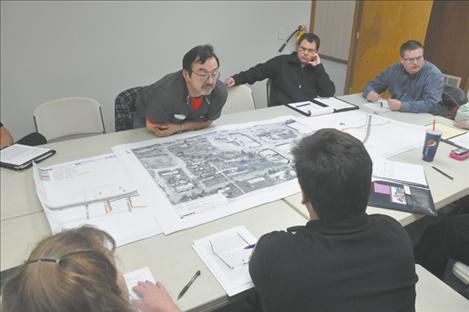Highway 93 expansion may hinge on Ronan vote
Hey savvy news reader! Thanks for choosing local.
You are now reading
1 of 3 free articles.
RONAN — The future of a $40 million Highway 93 expansion project slated for construction in 2018 could hinge on the January decisions of the Ronan City Council.
During a meeting held last Wednesday between design engineers, the Montana Department of Transportation and the City of Ronan, Ronan council members and Mayor Kim Aipperspach asked representatives of the Federal Highway Administration to seek a preliminary determination in regards to whether the proposed project could have impacts to Bockman Park classified under federal guidelines as “constructive use impacts.”
If the project is determined to have a “constructive use” impact on Bockman Park, it could require a complete re-routing of the project to provide minimal impact on the park.
Ronan Parks and Recreation Board Chairman Tom McDonald argued that the creation of the four-lane highway with a southbound couplet where First Avenue currently lies, will impact access to the park by taking away more than 60 parking spaces. People will also likely avoid the part of the park where most community events are currently held due to proximity to the high-volume roadway, McDonald said. This will change the park’s “constructive use,” McDonald said. The city asked for mitigation to this impact by providing additional parking and restrooms at a previous meeting. Federal officials were unresponsive to the request for new restrooms or other facilities because of limitations of federal guidelines.
“Our regulations are very stringent,” said Brian Hasselbach of the Federal Highway Administration.
The City is currently withholding its letter of de minimis, a document that states the city approves the project and allows plans to move forward. By withholding the letter and using it as a bargaining chip, the city has had significant say in the design of the highway project. Most recently, KLJ Engineering firm designed a wall just inside the eastern park boundary that will help separate traffic from the park. After Wednesday’s meeting, Aipperspach said he believed the council liked the idea of the wall. The engineers also identified areas around Ronan that could be acquired to create additional parking to mitigate spaces lost to the project, but those spaces are several blocks away. The engineering firm cannot move further in the design of the project until the City makes a decision on whether or not to pursue a “constructive use” determination, because those findings could impact design.
A “constructive use” ruling would give the City less input in the design process because federal guidelines prohibit de minimis and “constructive use” to be applied together.
“If we make an argument for ‘constructive use,’ we can’t make a de minimis determination,” Hasselbach said.
Larry Brazda, design coordinator for CSKT, MDT, and the Federal Highways Administration, called pursuing a “constructive use” determination a “double-edged sword” because if the federal government determines there is no impact, then the City has lost all input power for nothing. The project will proceed without any more discussion with the City, and it will be stuck with whatever plan the federal government comes up without any input.
“It could particularly hamstring (the City) with where you prefer the alignment to go,” Hasselbach said. “That’s just how the process works.”
Hasselbach said the local Federal Highway Administration office did not think the City’s argument for “constructive use” would hold up to federal guidelines.
McDonald said the City provided documentation during the planning process that should have been taken into consideration.
“The problem here is that your first environmental review didn’t address ‘constructive use,’” McDonald said. “You didn’t recognize any constructive uses in your supplemental environmental impact statement. You just claim there wasn’t any impact.”
The City asked Hasselbach to seek a preliminary determination from a higher office to see if they should pursue a “constructive use” determination.
Hasselbach is expected to give the City an answer by the end of January, when the Council can vote on the issue.
If the City seeks a “constructive use” determination, evaluation of the project could last another year, and put funding for the project in jeopardy.
Kevin Howlett, chair of the Montana Department of Transportation Commission, told the Council in a November meeting that funding must be approved five years before construction, and if a design agreement can’t be approved, he will allocate the $40 million to other highway projects in Western Montana.
It’s not the intention of the City to delay the project, council member Cal Hardy said.
“I don’t want to puff up my chest, stand here make the project go away and lose this,” Hardy said. “I’d like to see a win-win ... You say we’d have to do the assessment over again. It’s going to delay everything. That’s not what I want. I’d like to move forward.”
After the meeting, Aipperspach said he thought the project moved closer to becoming a reality.
“More information is always better,” he said.
















